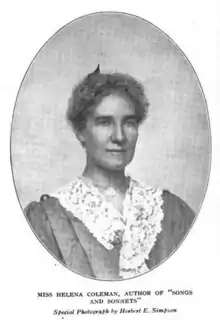Helena Coleman
Helena Coleman (April 27, 1860 — December 7, 1953) was a Canadian poet, music teacher, and writer.
Helena Coleman | |
|---|---|
 Helena Coleman, from a 1907 publication. | |
| Born | Helena Jane Coleman April 27, 1860 Newcastle, Ontario, Canada |
| Died | December 7, 1953 (aged 93) Toronto, Ontario, Canada |
| Nationality | Canadian |
| Occupation | Poet, music teacher, writer |
Early life
Helena Jane Coleman was born in Newcastle, Ontario, the daughter of the Rev. Francis Coleman, a Methodist minister,[1] and his second wife, Jane C. Gould. Her English-born mother died in 1862. One of her five older half-brothers was geologist Arthur Philemon Coleman. (Her father's first wife, Emmeline Maria Adams Coleman, was a descendant of John Quincy Adams, and sister of educator Mary Electa Adams.)[2]
She attended Ontario Ladies' College in Whitby, Ontario, with further study in Germany.[3]
Career
Coleman taught piano at Ontario Ladies' College from 1880 to 1892, as head of the music department, while her brothers' aunt Mary Electa Adams was the principal.[4] There she was a friend and colleague of Margaret Addison, who became a dean of the school.[3] Coleman was also a friend of New Zealand writer Edith Joan Lyttelton, during her stays in Canada.[5] Coleman was a mentor to Canadian poet Marjorie Pickthall.[6][7][8] Her friendship with fellow Canadian poet Ethelwyn Wetherald was especially intimate.[9]
Coleman's poems appeared under dozens of pseudonyms (using masculine, feminine, and indeterminate names) in many Canadian and American magazines, including Atlantic Monthly, Collier's, and Ladies' Home Journal, until 1906, when she published Songs and Sonnets (1906) under her own name, by the Tennyson Club of Toronto.[10] Further poetry collections were Marching Men: War Verses (1917)[11] and Songs (1937).[12] Her stories and articles continued to appear under various pseudonyms. Another book by her, Sheila and Others (1920), was a collection of short stories and bore the byline "Winifred Cotter".[13] She was a member of the Canadian Authors Association, and of the University Women's Club of Toronto.
Personal life
Helena Coleman used crutches that she called her "helpers", after surviving polio in childhood. After 1928 she used a wheelchair. Coleman lived most of her life in Toronto with her brother Arthur, and with a niece, Helen Coleman. She died in 1953, aged 93 years, in Toronto.[14] Her papers are archived in the E. J. Pratt Library at Victoria University.[13]
References
- John William Garvin, Canadian Poets and Poetry (Frederick A. Stokes Company 1916): 205-212.
- "Helena Jane Coleman" Canada's Early Women Writers (Simon Fraser University Digital Collections).
- Jean O'Grady, Margaret Addison: A Biography (McGill- Queen's University Press 2001): 48. ISBN 9780773521520
- Johanna Selles, Methodists and Women's Education in Ontario, 1836-1925 (McGill-Queen's University Press 19996): 213. ISBN 9780773514430
- Terry Sturm, An Unsettled Spirit: The Life and Frontier Fiction of Edith Lyttleton (University of Calgary Press 2003): 14, 116.ISBN 9781552381281
- Elizabeth Popham, David G. Pitt, eds., E. J. Pratt: Letters (University of Toronto Press 2017): 573, notes 144 and 145. ISBN 9781442650237
- Sandra Campbell, Both Hands: A Life of Lorne Pierce of Ryerson Press (McGill-Queen's University Press 2013). ISBN 9780773588653
- Diana M. A. Relke, Greenwor(l)ds: Ecocritical Readings of Canadian Women's Poetry (University of Calgary Press 1999): 83. ISBN 9781552380178
- Jennifer Chambers, "'You Woman-Hearted, Poet-Brained Wonder Worker,': The Poetic Dialogue of Love Between Ethelwyn Wetherald and Helena Coleman" Canadian Poetry 57 (Fall/Winter 2005): 65-85.
- W. T. Allison, "A New Canadian Poet" Canadian Magazine (February 1907): 404-408.
- John William Garvin, ed., Canadian Poems of the Great War (McClelland & Stewart 1918): 46-51.
- Helena Coleman, Songs (Ryerson Press 1937).
- Helena Coleman Fonds, E. J. Pratt Library, Special Collections, Victoria University.
- Elcie Pomeroy, "Tribute to Helena Coleman, Poet Native of Village of Newcastle" The Canadian Statesman (January 14, 1954): 6.
External links
- Helena Jane Coleman's gravesite on Find a Grave.
- Poems by Coleman at Sonnets.org.
- Coleman in SFU Digitized Collections, Simon Fraser University, Coll. Canada's Early Women Writers (with a photograph)